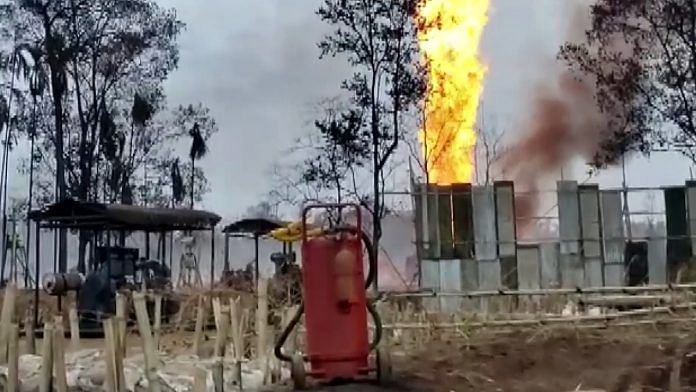On the day India was expressing outrage over the killing of a pregnant elephant in Kerala’s Palakkad district, an oil well exploded in Baghjan, Assam, near the Dibru-Saikhowa National Park, releasing a continuous stream of natural gas into the atmosphere.
The leak resulted in two deaths, and the displacement of over 3,000 local people, yet there has been a deafening silence about the incident in mainstream media.
The oil leak has failed to get the kind of coverage that the Vizag gas leak received. The chemical leak from the LG Polymers plant in Visakhapatnam on 7 May, which killed at least seven people and triggered panic in the industrial coastal city, caused widespread anguish and even evoked comparisons with the 1984 Bhopal gas tragedy.
Environmental issues have been on people’s minds after the Amazon fires last year, but the pattern highlights an unpleasant truth — we are conditioned to respond to the virality of pictures and videos, rather than focusing on what caused the incident.
One of India's biggest gaswell blowouts @OilIndiaLimited Baghjan #Assam today turned into an inferno pic.twitter.com/p2zyUjgXyO
— Rituparna Bhuyan (@rituparnabhuyan) June 9, 2020
Assam Natural Gas Leak: Baghjan Well Spewing Oil Since May 27, Scores of Fish Including Gangetic Dolphins Feared Dead, Here's What We Know So Far (For global wildlife news, download WildTrails (Android & iOS) https://t.co/vkCSZOH7yA) pic.twitter.com/l1DvXBGUE1
— WildTrails – Ultimate Wildlife Holiday Experiences (@_WildTrails) June 8, 2020
But if an image must go viral to stoke people’s conscience, let it be the image of a carcass of an endangered Gangetic dolphin found in the Maguri-Motapung wetland that reveals just how much the oil leak has impacted the region’s biodiversity. A dead snake, a variety of fish and birds from the wetland have also been reportedly killed by the leak.
5days..And oil and toxic gas still coming out of Baghjan oil filed Tinsukia,Assam. Oil India limited yet to control the leak and oil well blow out. As a result locals had to leave their houses. River dolphin dying.biodiversity under threat. @dpradhanbjp pic.twitter.com/4nlHsbEC1u
— Jyotideep Baishya (@jyotideepb) May 31, 2020
The Gangetic dolphin’s body was found by locals on 31 May — four days the pregnant elephant in Kerala was discovered dead. Former union minister and BJP MP Maneka Gandhi condemned the elephant’s killing, but appeared to be completely unaware of the impact of Assam’s oil leak on the rich biodiversity of the region.
Nor has any celebrity, activist or public figure, expect those from the Northeast, spoken about the extent of damage done to the land in and around the oil well.
This begs the question — are the animals in India’s Northeast less important, and their lives do not matter?
Also read: Assam oil well fire claims 2 lives, Baghjan villagers protest ‘lack of prompt response’
Damage to biodiversity
The State-run Oil India Limited (OIL), the owner of the oil well, has called in foreign experts to get the leak under control. But locals and environmental activists say severe damage has already been done to the biodiversity and essential local agriculture in the area.
Locals from Baghjan have been protesting for the past week over the damage the gas leak has caused their homes and natural environment, but India seems more focused on the massive oil spill in Russia.
While each disaster should get its due coverage, the blind eye turned to the Assam oil leak has reignited the old grudge people from the Northeast have regarding mainland India ignoring its issues.
NAPM expresses solidarity with demands of women from Rongagora, Milanpur & other villages (Assam) for safeguarding their wetlands at Maguri-Motapung & protesting the @OilIndiaLimited gas leaks.@CMOfficeAssam must stop Oil & Gas Drilling in #dibrusaikhowa #WorldEnvironmentDay2020 pic.twitter.com/0MrKmywX10
— NAPM India (@napmindia) June 5, 2020
Problems don’t exist in Northeast India
In May this year, OIL was given permission to drill in seven locations in Dibru-Saikhowa National Park, despite protests by various groups. But the company maintained it was not drilling in areas that fell under the Eco Sensitive Zone.
A few days before that, the National Board for Wildlife (NBWL) gave its nod for coal mining in the ecologically-sensitive Dehing Patkai Elephant Reserve in Assam.
When Minister of Environment, Forest & Climate Change Prakash Javadekar initiated an inquiry into the death of the pregnant elephant in Kerala, Congress MP Gaurav Gogoi asked him to also look into how the mining in the Dehing Patkai reserve would affect elephants in Assam.
Respected @PrakashJavdekar ji, I’m pleased to see your concern for elephants. Please ensure that your Ministry issue the necessary instruction to stop Coal mining inside the Dehing Patkai Rainforest in Assam which is an elephant corridor. #Elephant https://t.co/aT6ikFGkXz
— Gaurav Gogoi (@GauravGogoiAsm) June 4, 2020
Gogoi’s question might seem yet another instance of whataboutery, but it points to a tendency of selective outrage, especially when it comes to issues concerning the Northeast.
Perhaps it is the fault of the region itself, and its apparent failure to generate gut-wrenching, viral images for people to share on social media and hope the rest of India responds to its concerns.
Views are personal.
Also read: Lockdown brought cute images of dancing peacocks, not rhino poaching, Uttarakhand forest fires



